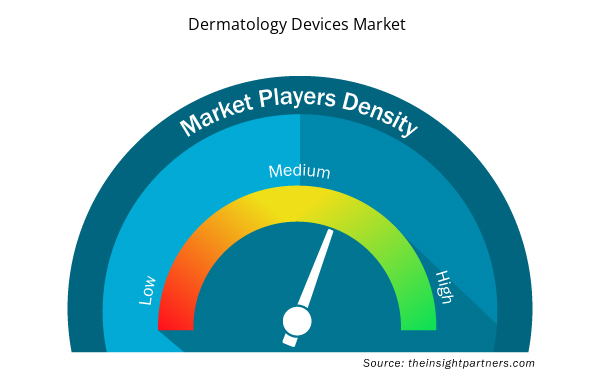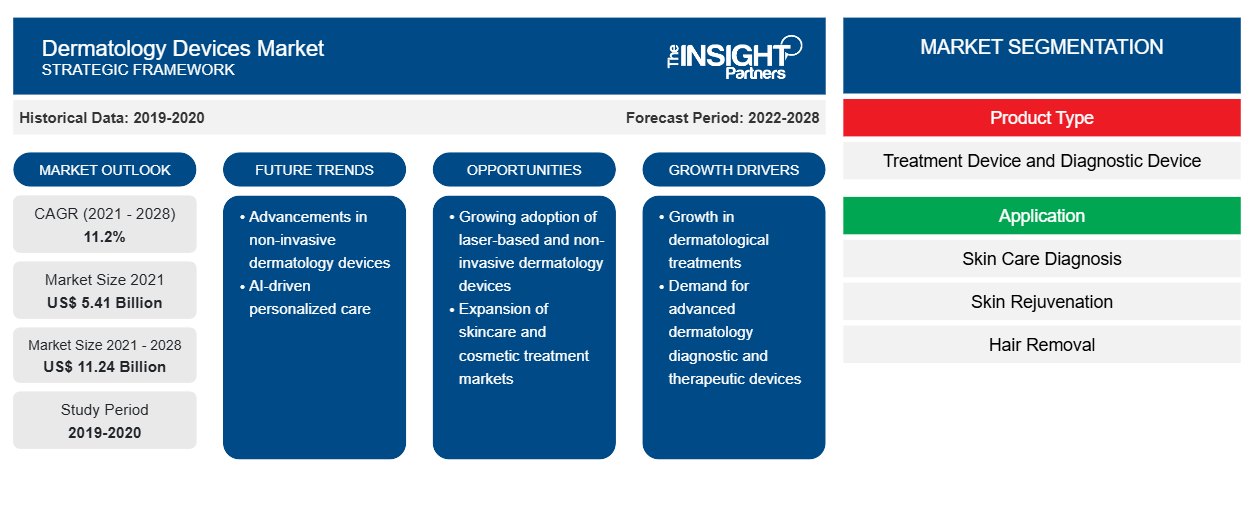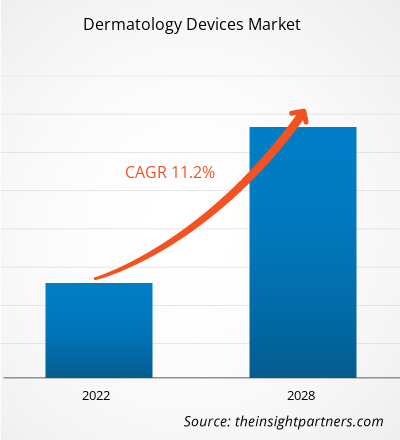Der weltweite Markt für dermatologische Geräte wurde im Jahr 2021 auf 5.408,57 Millionen US-Dollar geschätzt. Von 2022 bis 2028 wird ein durchschnittliches jährliches Wachstum von 11,2 % erwartet.
Der Bericht beleuchtet die vorherrschenden Trends auf dem Markt für Dermatologiegeräte und die Faktoren, die sein Wachstum vorantreiben. In der Dermatologie wird eine breite Palette medizinischer Geräte zur Durchführung kosmetischer und medizinischer dermatologischer Verfahren verwendet. Dermatologiegeräte helfen bei der Diagnose und Behandlung verschiedener Hauterkrankungen wie Hautkrebs und Psoriasis. Sie können auch für Kryochirurgie, photodynamische Therapie, Mohs-Mikrochirurgie sowie Elektrodesikkation und Kürettage verwendet werden. Die Food and Drug Administration (FDA) spielt eine entscheidende Rolle bei der Regulierung, Zulassung und Überwachung dieser Geräte nach der Markteinführung und gewährleistet ihre Sicherheit und Wirksamkeit.
Der Bericht bietet Einblicke und eine eingehende Analyse des globalen Marktes für Dermatologiegeräte und hebt dabei verschiedene Parameter hervor, darunter Markttrends, technologische Fortschritte, Marktdynamik und die Analyse der Wettbewerbslandschaft führender Marktteilnehmer. Er umfasst auch die Auswirkungen der COVID-19-Pandemie auf den Markt in allen Regionen. COVID-19 hatte insgesamt gemischte Auswirkungen auf den globalen Markt für Dermatologiegeräte. Die Gesundheitssysteme waren inmitten dieser globalen Gesundheitskrise überlastet, und die medizinische Versorgung aller Patienten wurde in vielen Regionen zu einer zentralen Herausforderung. Darüber hinaus hatten Medizingerätehersteller mit dem Fortschreiten der COVID-19-Pandemie Schwierigkeiten, ihren Betrieb zu verwalten. Viele Hersteller von Dermatologiegeräten, die in den USA geschäftlich tätig sind, waren durch den weit verbreiteten Ausbruch der Krankheit negativ betroffen. Nachdem die Pandemiebeschränkungen jedoch als Reaktion auf die sinkende Zahl der Fälle gelockert wurden, normalisierte sich die Zahl der von Dermatologen durchgeführten ästhetischen Eingriffe wieder, da die Krankenhäuser begannen, Wahleingriffe wieder aufzunehmen, was die Nachfrage nach Dermatologiegeräten ankurbelte.
Passen Sie diesen Bericht Ihren Anforderungen an
Sie erhalten kostenlos individuelle Anpassungen an jedem Bericht, einschließlich Teilen dieses Berichts oder einer Analyse auf Länderebene, eines Excel-Datenpakets sowie tolle Angebote und Rabatte für Start-ups und Universitäten.
- Holen Sie sich die wichtigsten Markttrends aus diesem Bericht.Dieses KOSTENLOSE Beispiel umfasst eine Datenanalyse von Markttrends bis hin zu Schätzungen und Prognosen.
Markt für Dermatologiegeräte – Geographiebasierte Einblicke
Geografisch ist der globale Markt für dermatologische Geräte in Nordamerika (USA, Kanada und Mexiko), Europa (Deutschland, Großbritannien, Frankreich, Italien, Spanien und übriges Europa), Asien-Pazifik (China, Japan, Indien, Südkorea, Australien und restlicher Asien-Pazifik-Raum), Süd- und Mittelamerika (Brasilien, Argentinien und restliches Süd- und Mittelamerika) sowie den Nahen Osten und Afrika (Saudi-Arabien, Südafrika, Vereinigte Arabische Emirate und restlicher Naher Osten und Afrika) unterteilt.
Markteinblicke
Zunehmende Prävalenz von Hautkrebs und Hauterkrankungen
Laut dem Bericht der American Academy of Dermatology Association (AAD) ist Hautkrebs die am weitesten verbreitete Krebsart in den USA. Zur Information: Schätzungsweise werden in den USA täglich über 9.500 Menschen mit Hautkrebs diagnostiziert. Bei den meisten Hautkrebsfällen handelt es sich um nichtmelanozytären Hautkrebs (NMSC), von dem jährlich über 3 Millionen Amerikaner betroffen sind. Die höchste NMSC-Inzidenzrate haben Frauen, wobei die Rate bei der jüngeren Bevölkerung steigt. Die jährlichen Behandlungskosten von Hautkrebs belaufen sich in den USA auf 1,8 Milliarden US-Dollar, davon 4,8 Milliarden US-Dollar für NMSC und 3,3 Milliarden US-Dollar für Melanome. Darüber hinaus heißt es im Bericht von Frontiers SA, dass die Verbreitung von Hautkrebs ein globaler Trend ist. Hautbiopsie und histopathologische Untersuchung sind zur Bestätigung von Hautkrebs unabdingbar. So sind beispielsweise die Entwicklung von Bildgebungstechnologien, -methoden und -geräten zur Aufzeichnung und Analyse rasch fortgeschritten. Dermatoskopische Bildgebungsgeräte strahlen Licht auf die obere Hautschicht, um detaillierte Pigmentveränderungen zu beobachten und aufzuzeichnen. Darüber hinaus hat die Entwicklung hochauflösender nichtinvasiver Diagnosegeräte wie Konfokalmikroskopie und Multiphotonenmikroskopie, mit denen Hautläsionen auf Zellebene ohne Biopsie erkannt werden können, auf dem Markt breite Akzeptanz gefunden. Solche innovativen Entwicklungen helfen effektiv bei der Diagnose von Hautkrebs, beim genauen Ablesen von Veränderungen bei verdächtigen Läsionen und bei der Effektivität nachfolgender Hautkrebsoperationen.
Hauterkrankungen sind weltweit ein großes Problem bei Jugendlichen und Erwachsenen. Akne, Psoriasis und Rosazea gehören zu den häufigsten Hauterkrankungen in der Bevölkerung. Zur Erinnerung: Akne ist die häufigste Hauterkrankung, von der laut Schätzungen der AAD jährlich bis zu 50 Millionen Amerikaner betroffen sind. Darüber hinaus leiden in den USA etwa 7,5 Millionen Menschen an Psoriasis, die vor allem bei Erwachsenen auftritt, wobei der höchste Anteil zwischen 45 und 64 Jahren auftritt. Darüber hinaus ist Rosazea eine häufige Hauterkrankung, von der laut dem von der AAD veröffentlichten Bericht jährlich 16 Millionen Amerikaner betroffen sind. Die Diagnose solcher Hauterkrankungen kann mithilfe künstlicher Intelligenz (KI) effektiv durchgeführt werden. Solche Faktoren würden in den Jahren 2022–2028 lukrative Möglichkeiten für den gesamten globalen Markt für Dermatologiegeräte bieten.
Markt für dermatologische Geräte – Produktbasierte Einblicke
Basierend auf dem Produkttyp ist der globale Markt für Dermatologiegeräte in Behandlungsgeräte und Diagnosegeräte unterteilt. Das Segment Behandlungsgeräte hatte im Jahr 2021 einen größeren Marktanteil.
Markt für Dermatologiegeräte – anwendungsbasierte Einblicke
Basierend auf der Anwendung ist der globale Markt für Dermatologiegeräte in Hautkrebsdiagnose, Hautverjüngung, Haarentfernung, Körperkonturierung und Hautstraffung, Psoriasis und andere unterteilt. Das Segment Hautkrebsdiagnose hatte im Jahr 2021 den größten Marktanteil.
Regionale Einblicke in den Markt für Dermatologiegeräte
Die regionalen Trends und Faktoren, die den Markt für Dermatologiegeräte im Prognosezeitraum beeinflussen, wurden von den Analysten von Insight Partners ausführlich erläutert. In diesem Abschnitt werden auch die Marktsegmente und die Geografie für Dermatologiegeräte in Nordamerika, Europa, im asiatisch-pazifischen Raum, im Nahen Osten und Afrika sowie in Süd- und Mittelamerika erörtert.

- Erhalten Sie regionale Daten zum Markt für Dermatologiegeräte
Umfang des Marktberichts zu Dermatologiegeräten
| Berichtsattribut | Details |
|---|---|
| Marktgröße im Jahr 2021 | 5,41 Milliarden US-Dollar |
| Marktgröße bis 2028 | 11,24 Milliarden US-Dollar |
| Globale CAGR (2021 - 2028) | 11,2 % |
| Historische Daten | 2019-2020 |
| Prognosezeitraum | 2022–2028 |
| Abgedeckte Segmente | Nach Produkttyp
|
| Abgedeckte Regionen und Länder | Nordamerika
|
| Marktführer und wichtige Unternehmensprofile |
|
Marktteilnehmerdichte für Dermatologiegeräte: Auswirkungen auf die Geschäftsdynamik verstehen
Der Markt für Dermatologiegeräte wächst rasant, angetrieben durch die steigende Nachfrage der Endnutzer aufgrund von Faktoren wie sich entwickelnden Verbraucherpräferenzen, technologischen Fortschritten und einem größeren Bewusstsein für die Vorteile des Produkts. Mit steigender Nachfrage erweitern Unternehmen ihr Angebot, entwickeln Innovationen, um die Bedürfnisse der Verbraucher zu erfüllen, und nutzen neue Trends, was das Marktwachstum weiter ankurbelt.
Die Marktteilnehmerdichte bezieht sich auf die Verteilung der Firmen oder Unternehmen, die in einem bestimmten Markt oder einer bestimmten Branche tätig sind. Sie gibt an, wie viele Wettbewerber (Marktteilnehmer) in einem bestimmten Marktraum im Verhältnis zu seiner Größe oder seinem gesamten Marktwert präsent sind.
Die wichtigsten auf dem Markt für dermatologische Geräte tätigen Unternehmen sind:
- Alma Lasers (Sisram Medical)
- Cutera Inc.
- Candela Corporation
- Solta Medical (Bausch Health Companies Inc.)
- FotoFinder Systems
Haftungsausschluss : Die oben aufgeführten Unternehmen sind nicht in einer bestimmten Reihenfolge aufgeführt.

- Überblick über die wichtigsten Akteure auf dem Markt für Dermatologiegeräte
Markt für Dermatologiegeräte – Erkenntnisse auf Endbenutzerbasis
Basierend auf den Endverbrauchern ist der globale Markt für dermatologische Geräte in Krankenhäuser, dermatologische Kliniken und andere unterteilt. Das Krankenhaussegment hielt 2021 den größten Marktanteil. Es wird jedoch erwartet, dass das Segment dermatologischer Kliniken zwischen 2022 und 2028 mit der höchsten CAGR in % wachsen wird.
Alma Lasers (Sisram Medical), Cutera Inc., Candela Corporation, Solta Medical (Bausch Health Companies Inc.), FotoFinder Systems's, Cynosure, Lumenis, El.En SpA, Leica Microsystem, Aerolase Corp. gehören zu den wichtigsten Akteuren auf dem globalen Markt für Dermatologiegeräte. Die Marktteilnehmer haben organische Strategien, darunter Produkteinführung und -erweiterung, eingesetzt, um ihre Präsenz und Produktportfolios weltweit zu erweitern.
- Historische Analyse (2 Jahre), Basisjahr, Prognose (7 Jahre) mit CAGR
- PEST- und SWOT-Analyse
- Marktgröße Wert/Volumen – Global, Regional, Land
- Branche und Wettbewerbsumfeld
- Excel-Datensatz


- Hydrogen Storage Alloys Market
- Semiconductor Metrology and Inspection Market
- Print Management Software Market
- Smart Parking Market
- Electronic Signature Software Market
- Artificial Turf Market
- Visualization and 3D Rendering Software Market
- Sports Technology Market
- Micro-Surgical Robot Market
- Airport Runway FOD Detection Systems Market

Report Coverage
Revenue forecast, Company Analysis, Industry landscape, Growth factors, and Trends

Segment Covered
This text is related
to segments covered.

Regional Scope
North America, Europe, Asia Pacific, Middle East & Africa, South & Central America

Country Scope
This text is related
to country scope.
Häufig gestellte Fragen
Alma Lasers (Sisram Medical), Cutera Inc., Candela Corporation, Solta Medical (Bausch Health Companies Inc.), FotoFinder Systems's, Cynosure, Lumenis, El.En SpA, Leica Microsystem, Aerolase Corp. among others are among the leading companies operating in the Dermatology Devices market.
Dermatology Devices market is segmented by countries comprising of North America, Europe, Asia Pacific, Middle East & Africa, and South & Central America.
The hospitals segment dominated the Dermatology Devices market and accounted for the largest market share of 53.64% in 2021.
Based on the application, skin cancer diagnosis segment took the forefront leaders in the worldwide market by accounting largest share in 2021 and is expected to continue to do so till the forecast period.
Based on product, the treatment device segment took the forefront leaders in the worldwide market by accounting largest share in 2021 and is expected to continue to do so till the forecast period.
Growing Prevalence of Skin Cancers and Skin Disorders are the most significant factors responsible for the overall market growth.
Dermatology is a specialty that employs a wide range of medical devices, from cosmetic applications to medical dermatology. Additionally, dermatology devices help in diagnosing and treating skin disorders. Also, these devices are intended for cryosurgery, photodynamic therapy, Moh's micrographic surgery, and electrodesiccation & cutterage. The Food and Drug Administration (FDA) plays a critical role in the regulation, approval, and post-marketing surveillance regarding the safety and efficacy of these devices.
Trends and growth analysis reports related to Life Sciences : READ MORE..
The List of Companies - Dermatology Devices Market
- Alma Lasers (Sisram Medical)
- Cutera Inc.
- Candela Corporation
- Solta Medical (Bausch Health Companies Inc.)
- FotoFinder Systems's
- Cynosure
- Lumenis
- El.En SpA
- Leica Microsystem
- Aerolase Corp.
The Insight Partners performs research in 4 major stages: Data Collection & Secondary Research, Primary Research, Data Analysis and Data Triangulation & Final Review.
- Data Collection and Secondary Research:
As a market research and consulting firm operating from a decade, we have published and advised several client across the globe. First step for any study will start with an assessment of currently available data and insights from existing reports. Further, historical and current market information is collected from Investor Presentations, Annual Reports, SEC Filings, etc., and other information related to company’s performance and market positioning are gathered from Paid Databases (Factiva, Hoovers, and Reuters) and various other publications available in public domain.
Several associations trade associates, technical forums, institutes, societies and organization are accessed to gain technical as well as market related insights through their publications such as research papers, blogs and press releases related to the studies are referred to get cues about the market. Further, white papers, journals, magazines, and other news articles published in last 3 years are scrutinized and analyzed to understand the current market trends.
- Primary Research:
The primarily interview analysis comprise of data obtained from industry participants interview and answers to survey questions gathered by in-house primary team.
For primary research, interviews are conducted with industry experts/CEOs/Marketing Managers/VPs/Subject Matter Experts from both demand and supply side to get a 360-degree view of the market. The primary team conducts several interviews based on the complexity of the markets to understand the various market trends and dynamics which makes research more credible and precise.
A typical research interview fulfils the following functions:
- Provides first-hand information on the market size, market trends, growth trends, competitive landscape, and outlook
- Validates and strengthens in-house secondary research findings
- Develops the analysis team’s expertise and market understanding
Primary research involves email interactions and telephone interviews for each market, category, segment, and sub-segment across geographies. The participants who typically take part in such a process include, but are not limited to:
- Industry participants: VPs, business development managers, market intelligence managers and national sales managers
- Outside experts: Valuation experts, research analysts and key opinion leaders specializing in the electronics and semiconductor industry.
Below is the breakup of our primary respondents by company, designation, and region:

Once we receive the confirmation from primary research sources or primary respondents, we finalize the base year market estimation and forecast the data as per the macroeconomic and microeconomic factors assessed during data collection.
- Data Analysis:
Once data is validated through both secondary as well as primary respondents, we finalize the market estimations by hypothesis formulation and factor analysis at regional and country level.
- Macro-Economic Factor Analysis:
We analyse macroeconomic indicators such the gross domestic product (GDP), increase in the demand for goods and services across industries, technological advancement, regional economic growth, governmental policies, the influence of COVID-19, PEST analysis, and other aspects. This analysis aids in setting benchmarks for various nations/regions and approximating market splits. Additionally, the general trend of the aforementioned components aid in determining the market's development possibilities.
- Country Level Data:
Various factors that are especially aligned to the country are taken into account to determine the market size for a certain area and country, including the presence of vendors, such as headquarters and offices, the country's GDP, demand patterns, and industry growth. To comprehend the market dynamics for the nation, a number of growth variables, inhibitors, application areas, and current market trends are researched. The aforementioned elements aid in determining the country's overall market's growth potential.
- Company Profile:
The “Table of Contents” is formulated by listing and analyzing more than 25 - 30 companies operating in the market ecosystem across geographies. However, we profile only 10 companies as a standard practice in our syndicate reports. These 10 companies comprise leading, emerging, and regional players. Nonetheless, our analysis is not restricted to the 10 listed companies, we also analyze other companies present in the market to develop a holistic view and understand the prevailing trends. The “Company Profiles” section in the report covers key facts, business description, products & services, financial information, SWOT analysis, and key developments. The financial information presented is extracted from the annual reports and official documents of the publicly listed companies. Upon collecting the information for the sections of respective companies, we verify them via various primary sources and then compile the data in respective company profiles. The company level information helps us in deriving the base number as well as in forecasting the market size.
- Developing Base Number:
Aggregation of sales statistics (2020-2022) and macro-economic factor, and other secondary and primary research insights are utilized to arrive at base number and related market shares for 2022. The data gaps are identified in this step and relevant market data is analyzed, collected from paid primary interviews or databases. On finalizing the base year market size, forecasts are developed on the basis of macro-economic, industry and market growth factors and company level analysis.
- Data Triangulation and Final Review:
The market findings and base year market size calculations are validated from supply as well as demand side. Demand side validations are based on macro-economic factor analysis and benchmarks for respective regions and countries. In case of supply side validations, revenues of major companies are estimated (in case not available) based on industry benchmark, approximate number of employees, product portfolio, and primary interviews revenues are gathered. Further revenue from target product/service segment is assessed to avoid overshooting of market statistics. In case of heavy deviations between supply and demand side values, all thes steps are repeated to achieve synchronization.
We follow an iterative model, wherein we share our research findings with Subject Matter Experts (SME’s) and Key Opinion Leaders (KOLs) until consensus view of the market is not formulated – this model negates any drastic deviation in the opinions of experts. Only validated and universally acceptable research findings are quoted in our reports.
We have important check points that we use to validate our research findings – which we call – data triangulation, where we validate the information, we generate from secondary sources with primary interviews and then we re-validate with our internal data bases and Subject matter experts. This comprehensive model enables us to deliver high quality, reliable data in shortest possible time.


 Holen Sie sich ein kostenloses Muster für diesen Bericht
Holen Sie sich ein kostenloses Muster für diesen Bericht